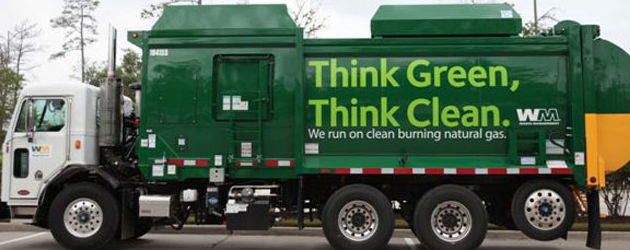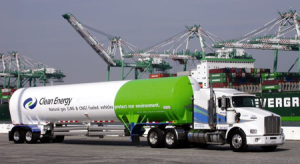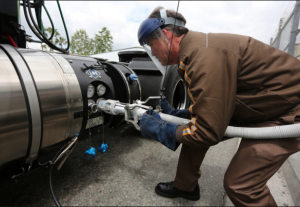Natural-gas vehicles haven’t caught on yet. Could that ever change?
 Courtesy of Washington Post by Brad Plumer: The United States is sitting on a vast reserve of cheap natural gas. And oil has become rather expensive in recent years. So the logical thing to do would be to start running many of our cars and trucks on natural gas, right?
Courtesy of Washington Post by Brad Plumer: The United States is sitting on a vast reserve of cheap natural gas. And oil has become rather expensive in recent years. So the logical thing to do would be to start running many of our cars and trucks on natural gas, right?
Energy experts and folks like T. Boone Pickens have been speculating about this option for years. The idea of liquefying or compressing natural gas and using it to power everything from 18-wheelers to automobiles has a powerful allure.
After all, the technology is proven and widely used in places like Brazil and Argentina. Natural gas is cheaper than gasoline — currently costing the equivalent of just $2.10 per gallon. It burns more cleanly, with fewer emissions. And a switch to natural gas could curtail our reliance on oil. The Natural Resources Defense Council has estimated that Pickens’s proposal to switch the U.S. truck fleet to compressed natural gas could reduce oil consumption by one-quarter, or 4.9 million barrels per day.
 And yet… natural-gas vehicles have been extremely slow to catch on. Last year, out of 14.5 million new cars and trucks sold in the United States, just 20,381 ran on natural gas, estimates Dave Hurst of Pike Research. For context, automakers sold at least 50,000 plug-in electric cars.
And yet… natural-gas vehicles have been extremely slow to catch on. Last year, out of 14.5 million new cars and trucks sold in the United States, just 20,381 ran on natural gas, estimates Dave Hurst of Pike Research. For context, automakers sold at least 50,000 plug-in electric cars.
So what’s the holdup? Here’s a closer look at some of the obstacles — and whether natural-gas vehicles could ever catch on:
Passenger vehicles: It shouldn’t be a huge shock that Americans have been slow to warm to natural-gas cars. The vehicles are still far pricier than gasoline-powered cars — or even hybrids. It can take between 13 and 20 years for drivers to recoup those savings in lower fuel costs. What’s more, fueling stations are hard to find.
Case in point: Honda has been selling a Civic that runs on compressed natural gas since 2008. So far, sales have been fairly torpid, with just 1,500 sold last year. Why is that? Well, for one, the price starts at $26,305, or about $8,000 more than a gasoline-powered Civic and $2,000 more than the hybrid version.
The CNG car has other drawbacks, too. Since compressed natural gas is less dense than gasoline and requires a bigger fuel tank, the CNG Civic has less cargo space and a shorter range (about 220 miles — less than a conventional car but more than a typical electric car).
Filling up is an even bigger hassle. There are fewer than 1,000 natural-gas fueling stations around the country, and only about half of those are available to the public. The stations themselves can be expensive to build, and they aren’t getting any more plentiful. In fact, electric-vehicle charging stations have rapidly outpaced them since 2011:
This helps explains why a 2011 MIT report argued that most ordinary drivers wouldn’t be fueling up with natural gas anytime soon: “High incremental costs of CNG vehicles lead to long payback times for the average driver, so significant penetration of CNG into the passenger fleet is unlikely in the short term.”
Long-haul trucking. Now this is an area where filling up with natural gas might make more sense — at least in theory. After all, long-haul trucks are driven more frequently, so high upfront costs aren’t as much of a deal-breaker. In addition, many long-haul trucks drive along set routes, so it should be easier to set up the fueling infrastructure.
But is this actually happening? The New York Times recently reported that some trucking companies are showing more interest in switching their 18-wheelers from diesel to liquefied natural gas. The savings — about $1.50 per gallon — are enticing. That said, progress was sluggish. And the most optimistic projections for the future are fairly modest: The federal Energy Information Administration last year projected that if enough L.N.G. filling stations were built and economic conditions were right, sales of heavy-duty natural gas vehicles could increase to 275,000 in 2035, equivalent to 34 percent of new vehicle sales, from 860 in 2010.
Even that might be too optimistic. Over at FT Alphaville, Kate Mackenzie scrutinizes the various anecdotes about firms like Walmart and UPS switching to natural-gas trucks. “On closer examination,” she writes, “their commitment to natural gas-powered vehicles appears to range from a minor passing interest to a slightly bigger, but still fairly minor, interest.”
One reason trucking companies may be so hesitant, Mackenzie notes, is that it’s tough to predict that natural gas prices will stay low — particularly if a whole bunch of trucking companies switch over to liquefied natural gas. “If all the big freight and transit operators converted to natural gas vehicles,” she notes, “how long would that feedstock advantage last?”
 Municipal vehicles. This was one area where the MIT report was more confident that natural gas vehicles could catch on: school buses, garbage trucks, delivery trucks. These are heavy-duty vehicles that don’t need to travel very far before refueling and where payback times can be as little as three years.
Municipal vehicles. This was one area where the MIT report was more confident that natural gas vehicles could catch on: school buses, garbage trucks, delivery trucks. These are heavy-duty vehicles that don’t need to travel very far before refueling and where payback times can be as little as three years.
Cities do seem quite interested in compressed natural-gas vehicles. About 1,600 CNG buses and 1,500 CNG garbage trucks were sold last year. (Washington D.C.’s metro system now has 461 natural gas buses in operation, a move aimed at saving money.)
That said, this is still a relatively niche market.
So… could this change? Could natural-gas vehicles become more popular? Michael Levi’s excellent new book, “The Power Surge,” discusses a couple of possible ways that natural-gas vehicles could gain a larger foothold:– Oil prices could go much, much higher. This could make natural-gas vehicles slightly more attractive, but only slightly. Levi estimates that if oil shot up to $200 a barrel, it would take just seven years for a consumer to recoup the higher cost of a natural-gas vehicle. On the other hand, in that scenario, gasoline-powered vehicles would presumably become more efficient, and electric vehicles would become more popular — so the competition would remain stiff.
- The cars could get much cheaper. “It’s a lot cheaper to buy a natural gas vehicle in Europe,” Levi writes. “[T]he natural gas version of the Volkswagon Passat, which can run on both natural gas and normal gasoline, costs only $3,700 more than the pure gasoline version. Researchers aren’t sure what explains the disparity, but it makes a stunning difference: If natural gas vehicles in the United States were to cost as little as they do in Europe… a sensible U.S. consumer could expect to break even after only five years.”
- Home fueling stations could become much cheaper. Millions of Americans already get natural gas piped to their homes, so why not just have home fueling stations? The problem is that these currently cost around $4,000 to $6,000. But Ford is trying to develop a model that costs just $500, in the hopes that this could make natural-gas vehicles more attractive. ”Once we get a good home refueling station,” a Ford official told the AP, “you’ll never have to go to a gas station again unless you like their coffee.”
- Governments could offer more incentives for natural-gas vehicles. Some examples: West Virginia offers a $7,500 tax credit for CNG car and light-truck purchases. Colorado offers $6,000. California allows natural-gas vehicles to drive in HOV lanes. Indiana is mulling a bill to expand fueling stations around the state. And President Obama has proposed expanding a variety of federal tax credits to promote natural-gas vehicles.
Of course, these proposals raise plenty of questions. Should the government be in the business of promoting alternative vehicles? And if so, does it make sense to promote natural-gas vehicles at the expense of other technologies — like hybrids or plug-ins? The MIT report suggested that it might just be easier and more efficient to use America’s natural gas to power electric cars rather than set up an entirely new fueling infrastructure. And, so far, the country is nudging along in exactly that direction.
Further reading:
–A recent study from the National Academy of Sciences explained how to cut U.S. gasoline use in half by 2030.
–By the way, a 2012 study in PNAS found that natural-gas cars would only be cleaner than gasoline-powered cars from a climate-change perspective if methane leaks were kept below 1.6 percent. Current leakage rates appear to be higher — here’s much more on that topic.
Category: Featured, General Update, Green










